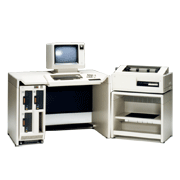A component-based office computer with freely configurable independent peripheral units.
Ricoh launched the RICOM 2000 office computer series in December 1979 as the culmination of both the RICOM and Ricoh PenCol series. Ricoh developed both the hardware and software for the computer, which featured a microprocessor CPU. It was distinguished by a daisy-chain architecture that linked together independent components (storage units, displays, keyboards, printers, etc.) by coaxial cables rather than connecting each directly to the CPU. The computer could be constantly kept up to the latest system specs because units could be added or replaced in conjunction with system upgrades.
The Ricoh floppy disk drive was an unusual output media at the time because it supported auto switching between single-sided/double-sided disks and single-density/double-density disks. A kanji-character printer was also available. Loaded with the Ricoh-developed COMPOS office computer operating system, the RICOM 2000 series could simultaneously process multiple, unrelated tasks even though it was a floppy-based office computer. (COMPOS was high-performance operating system that could run a number of languages, including JCL, an auto batch-processing language, RAPID, a basic language, and SAPORT, a multisearch processing function.) The computer had three memory size options: 64 kilobytes, 112 kilobytes, and 160 kilobytes. There were three input formats — a touch-pen unit, a push-button unit, and a typewriter unit — and three output formats — a high-speed dot matrix printer, a kanji-character dot matrix printer, and a typeset impact printer. The input and output units could be connected in any order for greater user convenience.
The RICOM 2000 series defined an age by capturing almost a quarter of the office computer market.


